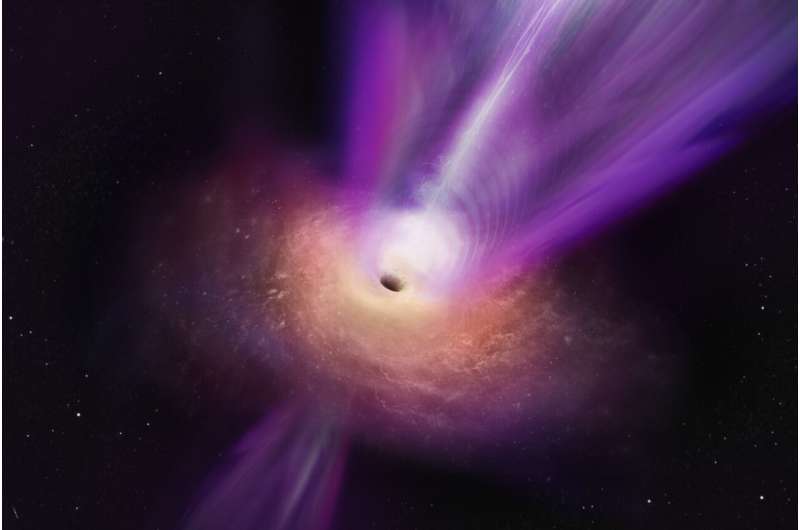NASA has released an animation to show the massive size of black holes.
- May 2, 2023
- 0
NASA has released a new animation to give you a real sense of space dominated by a supermassive black hole. These are the giants of the universe; spikes
NASA has released a new animation to give you a real sense of space dominated by a supermassive black hole. These are the giants of the universe; spikes

NASA has released a new animation to give you a real sense of space dominated by a supermassive black hole. These are the giants of the universe; spikes at the centers of galaxies; gravitational hearts around the stars in an orbital dance measured in ages. At the lower end of the scale, they start at about 100,000 times the mass of the Sun and can reach a maximum of tens of billions of solar masses.
These abstract numbers are fine, but it’s hard to imagine how big these things really are. And this is one of the great mysteries of the universe: While we have some ideas, we don’t know how they came to be.
“Direct measurements, most with the Hubble Space Telescope, confirm the existence of more than 100 supermassive black holes,” says theoretical astrophysicist Jeremy Schnittman of NASA’s Goddard Space Flight Center. “How do they get so big? When galaxies collide, their central black holes may eventually merge.”
In fact, black holes themselves may not be huge at all. Black holes are the densest objects we know of in the universe. They are so compact that we can only describe them mathematically as a singularity – a one-dimensional point of infinite density. Their densities are so great that space-time is gravitationally bent into what is actually a closed sphere around them. In this sphere, even light doesn’t have enough velocity to escape.
This is what we mean when we talk about the size of a black hole, its boundaries known as the event horizon. The larger the black hole, the larger the radius of the sphere defined by the event horizon, known as the Schwarzschild radius. For example, if the Sun were a black hole, the Schwarzschild radius would be only 2.95 kilometers (1.8 miles).
As far as we know, the smallest black holes are objects with a mass of about five times the mass of the Sun, meaning that the core of a very massive star collapses at the end of its life. These are stellar-mass black holes.
The upper limit of a black hole’s stellar mass is about 65 times the mass of the Sun, as the extremely massive progenitor stars that may have created these larger objects end their lives in a double unstable supernova explosion that completely destroys the core. nothing for collapse
However, we have seen stellar-mass black holes greater than 65 solar masses. When black holes collide and merge, they can result in an object with a common mass. But the path from them to supermassive and supermassive black holes is a huge void. Literally. There is a surprising scarcity of black holes detected in the mass range between stellar-mass and supermassive black holes.
But supermassive black holes also have a very large range. NASA’s new animation is a pretty striking look at this range, starting with a black hole in a dwarf galaxy named J1601+3113, which contains a black hole with about 100,000 solar masses. This would give it a Schwarzschild radius just under half the size of the Sun. The shadow from the black hole extends into the space around the event horizon, creating a region about twice as dark; this means that the shadow appears in the video about the same size as the Sun.
We also see a supermassive black hole at the center of our own galaxy, Sagittarius A*, moving around 4.3 million solar masses. There is also the first black hole, M87*, which is much larger with 5.37 billion Suns.
There are also two black holes hanging from the center of a galaxy called NGC 7727. NGC 7727 was once two galaxies. Two galactic core black holes of 154 million and 6.3 million solar masses, respectively, coalesced and sank into the center of the newly merged galaxy, where they would one day merge as well.
These black holes are a big clue that astronomers believe tell us one way supermassive black holes grow, and their merger should generate gravitational waves. However, the frequency of these mergers is too low for our current tools to detect.
One of the largest known black holes in the universe is a monster known as TON-618. In 2004, scientists measured its mass to be 66 billion solar masses. A theoretical upper mass limit for black holes is about 50 billion solar masses, but the universe defies theoretical predictions quite well.
The Schwarzschild radius of a black hole with such a mass would be more than 1300 astronomical units. For context, Pluto’s orbit is about 40 AU from the Sun. This thing will suck the solar system a hundred times over. Fortunately, it is far away; The age of its light is estimated to be 10.8 billion years, meaning it won’t hide to engulf our corner of space.
Source: Port Altele
As an experienced journalist and author, Mary has been reporting on the latest news and trends for over 5 years. With a passion for uncovering the stories behind the headlines, Mary has earned a reputation as a trusted voice in the world of journalism. Her writing style is insightful, engaging and thought-provoking, as she takes a deep dive into the most pressing issues of our time.